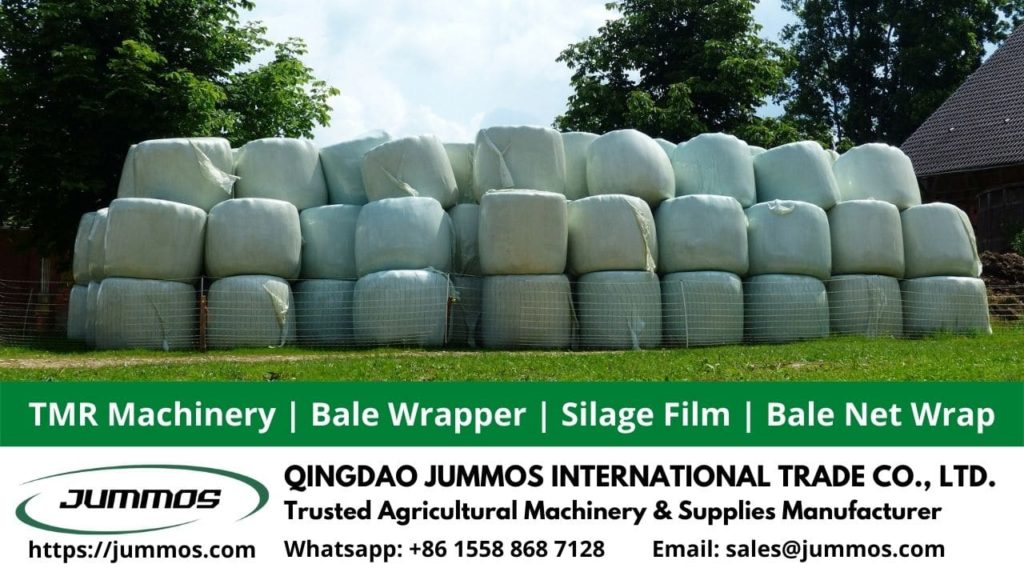Silage film wrap is one of the most important tools in the bale silage wrapping process. You have to be very selective in choosing the best plastic. Among other things, the plastic must be able to withstand punctures and tears and can protect the silage from exposure to ultraviolet light. Good packaging material will guarantee a perfect fermentation process in silage. The nutrients in silage are also potentially optimal, so they are great for increasing meat and milk production in your livestock.
As we know, making silage bales is one of the most effective solutions to free you from dependence on industrial feed. Making silage will also make feed management more efficient in soaring instant feed prices. You’ll even have an adequate supply of feed, even if it’s not fresh, when the lean season hits.
Many unique techniques and facts accompany the existence and function of silage film wrap. Maybe you will find a different wrapping technique from one area to another. This is usually influenced by the traditions and customs of the local community. Your job is to apply the techniques that best suit the needs of your farm.
Contents
Important Facts about Silage Film Wrap
Making silage from rolled bales of hay and other grass materials is a tough job, but it’s also an art that requires diligence and precision. Silage film wrap is an important component that must be available exclusively, but you also have to work around it so that its use is efficient. The following are important facts about plastic bale wrapping and the process of making bale silage:
Humidity Level
There’s no point in using a good silage film wrap when you wrap it the wrong way. Bale wrapper is widely used to ensure the wrapping process runs smoothly, tightly, and quickly. Wrap the silage as much as possible to create good fermentation conditions with high humidity levels.
When the bales are wrapped properly with high humidity, the silage harvest time will be faster and minimize forage damage. The packing technique should also ensure that oxygen is maintained in the bale and that the remainder is properly expelled. This will produce silage that is highly durable and safe for livestock.
Bale Wrapping Layer
Wrapping bales using silage film wrap has nothing to do with thickness. But the more layers on the bale, the denser the silage will be. A multi-layered bale will protect the silage from punctures and tears on the outside, as well as protect the feed from ultraviolet rays on the inside.
Choice of Silage Film Wrap Thickness
Plastic bale wraps are usually available in a wide selection of thicknesses, ranging from 1 to 1.5 millimeters. You should consult a trusted supplier when choosing the right plastic wrap. Make sure you choose the one with the highest puncture and tear resistance but still affordable.
Use of Special Machines
Today’s silage bale packaging is supported by modern technology. The existence of bale wrappers of various types makes it easy to wrap quickly and efficiently. The purchase of bale wrappers should be integrated with the investment agenda in the livestock sector because you will not get instant profits immediately after buying and using the machine.
Bale Wrapping Tips Using Silage Film Wrap
Packaging Time
Bale should be wrapped as soon as it starts the fermentation process. Do not leave the bale open for more than 24 hours, as this will degrade the quality of the silage. Delaying the packaging of the bales for days will open up direct contact with oxygen, and this will hinder the fermentation process.
Bale Storage Locations
We recommend that the packaging process is near the silage bale storage area. Short-distance transportation will minimize bale damage from the steep ground. As soon as it is wrapped, the bale will ferment. You should not move it to extremes as it will interfere with the fermentation process. If you need to move it, wait after 24 hours to prevent the fermentation gases from bursting.
Ideal Rotation of Packaging
The bale wrapping process using silage film wrap is generally carried out up to 6-8 rotations. This will be quite good at protecting the silage from rips or punctures. But the quality of the bale will affect how thickly you will coat it.
Recommended Best Silage Film Wrap Supplier
When you care about the quality of bale wrapping plastic, then we recommend working with Jummos. Our company provides high-quality polyethylene plastic bale wrapping. As a result, you will find a plastic that is strong and resistant to punctures and tears. You can choose the thickness of the silage film wrap according to your needs.
Not only providing the best plastic bale wrappers, but Jummos also supports a sustainable livestock business with a variety of supporting tools and machines, including various types of TMR mixers such as stationary TMR mixers, trailed TMR mixers, feed delivery boxes, and dung trucks. You can also get bale wrappers with various types and specifications. Among them are available combi bale wrapper, silage round baler, round baler wrapper, and other products.

